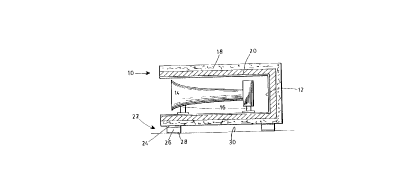Some of the information on this Web page has been provided by external sources. The Government of Canada is not responsible for the accuracy, reliability or currency of the information supplied by external sources. Users wishing to rely upon this information should consult directly with the source of the information. Content provided by external sources is not subject to official languages, privacy and accessibility requirements.
Any discrepancies in the text and image of the Claims and Abstract are due to differing posting times. Text of the Claims and Abstract are posted:
| (12) Patent: | (11) CA 2090806 |
|---|---|
| (54) English Title: | SOUND DAMPENING DEVICE FOR HORNS |
| (54) French Title: | DISPOSITIF D'AMORTISSEMENT SONORE POUR KLAXONS, SIRENES ET AUTRES AVERTISSEURS ASSIMILES |
| Status: | Deemed expired |
| (51) International Patent Classification (IPC): |
|
|---|---|
| (72) Inventors : |
|
| (73) Owners : |
|
| (71) Applicants : |
|
| (74) Agent: | ROBIC |
| (74) Associate agent: | |
| (45) Issued: | 1997-12-30 |
| (22) Filed Date: | 1993-03-02 |
| (41) Open to Public Inspection: | 1994-09-03 |
| Examination requested: | 1994-05-27 |
| Availability of licence: | N/A |
| (25) Language of filing: | English |
| Patent Cooperation Treaty (PCT): | No |
|---|
| (30) Application Priority Data: | None |
|---|
The horn housing may comprise an inner metal shell
in the shape of a hexagonal box open at one end fitting into
a similarly shaped outer dense solid box similarly open at
one end. Space between the inner and the outer boxes being
filled by a low density sound absorbing filler, and the
inner box being connected to the outer box by vibration
absorbing bolts. The outer box is mounted to a structure by
vibration absorbing mounting brackets. When a high decibel
horn or siren is mounted in the inner box to directed sound
through the opening, most of the sound propagating sideways
towards the structure is absorbed by the housing increasing
the comfort level of passengers or crew inside the
structure.
Le boîtier de klaxon peut comprendre une enveloppe métallique interne ayant la forme d'une boîte hexagonale ouverte à une extrémité et s'adaptant dans une boîte extérieure rigide, dense, de forme similaire, ouverte à une extrémité. L'espace entre la boîte intérieure et la boîte extérieure est rempli d'un matériau à faible masse volumétrique qui absorbe le son, et la boîte intérieure est fixée à la boîte extérieure au moyen de boulons antivibratiles. La boîte extérieure est montée à une structure à l'aide de supports absorbant les vibrations. Lorsqu'un klaxon ou une sirène à niveau sonore élevé sont montés dans la boîte intérieure pour transmettre le son par l'ouverture, la majorité du son qui se propage latéralement vers la structure est absorbé par le logement, ce qui contribue à accroître le confort des passagers ou de l'équipage se trouvant à l'intérieur de la structure.
Note: Claims are shown in the official language in which they were submitted.
Note: Descriptions are shown in the official language in which they were submitted.

For a clearer understanding of the status of the application/patent presented on this page, the site Disclaimer , as well as the definitions for Patent , Administrative Status , Maintenance Fee and Payment History should be consulted.
| Title | Date |
|---|---|
| Forecasted Issue Date | 1997-12-30 |
| (22) Filed | 1993-03-02 |
| Examination Requested | 1994-05-27 |
| (41) Open to Public Inspection | 1994-09-03 |
| (45) Issued | 1997-12-30 |
| Deemed Expired | 2008-03-03 |
There is no abandonment history.
Note: Records showing the ownership history in alphabetical order.
| Current Owners on Record |
|---|
| BAULTAR I.D. INC. |
| Past Owners on Record |
|---|
| ALBERT, ANDRE |
| ARCHAMBAULT, BRUNO |
| BAULTAR ERGO INC. |
| BAULTAR INC. |
| MALTAIS, MARIO |